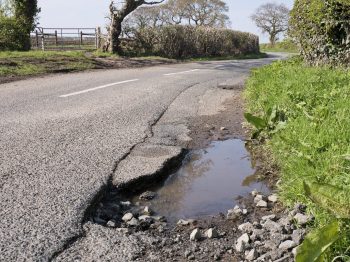Six in 10 drivers says potholes on local roads have worsened
Six in 10 drivers (60%) believe the condition of local roads they use regularly is worse than a year ago – up from 58% in 2021 and 52% in 2020.

55% say pothole repairs are poorly carried out
The research by the RAC found that just 4% think the state of the local roads in their area has improved in the past 12 months, down from 6% for the last two years.
The study, conducted among 3,102 drivers for the 2022 RAC Report on Motoring, also showed that road surface quality is the main reason drivers say the state of their local roads has deteriorated, cited by 98%. In total, 86% of drivers say they have to steer to avoid potholes on several occasions, rising to 90% among those in rural locations, but falling to 81% for those in urban areas.
But fading road markings are a growing problem: 63% said they had noticed them, up from 56% last year, while 42% report worsened signage visibility and 35% complain about the amount of litter by the roadside. Lack of grass and foliage maintenance is another problem, cited by 30% of drivers.
The RAC also asked drivers to rate the quality of repairs to potholes carried out by local authorities. The findings show that even when authorities are managing to repair local road surfaces, drivers are generally unhappy with the quality of the work: 55% rate the standard of pothole repairs in their area as ‘poor’ (35%) or ‘very poor’ (20%).
The research supports the RAC’s own ‘Pothole Index’, which shows there is little sign of improvement to the quality of local roads and finds that drivers are 1.6 times more likely to experience a breakdown due to a pothole than they were in 2006 – the starting point of the index’s data.
A lack of government funding to councils for repair work remains an issue for road quality.
Research by the Asphalt Industry Alliance (AIA) Annual Local Authority Road Maintenance (ALARM) for 2022 once again indicated local authorities in England and Wales do not have adequate funding to keep roads in a reasonable condition, despite a 4% increase in average highway maintenance budgets. The reported backlog of repairs has increased by almost 25% to over £12bn and will likely take more than a decade to complete.
The Local Government Association (LGA) has responded to the report.
Cllr David Renard, transport spokesperson, said: “Councils across the country are facing unprecedented increased costs to repair our local roads, keep our streetlights switched on and invest in improved local infrastructure. Latest LGA estimates reveal that the average cost of a pothole repair has increased by around 25%, with the cost of running streetlights nearly doubling.
“Research shows that, even before current levels of inflation, that existing levels of funding will lead to a gradual decline in road conditions.
“The Government should meet these increased costs in the upcoming Autumn Statement, otherwise they risk the current pothole repair backlog growing even longer and councils being forced to cut back on essential road repairs.”
The RAC renewed its call for the local road network to receive some form of ringfenced funding, allowing councils to maintain their roads properly and regularly.
However, its research has found that while 80% drivers would support such a plan, there has been a decline in the percentage who would be willing to pay a higher level of fuel duty, provided this money was ringfenced for a local pothole fund. Only 28% support such a proposal in 2022, down from 43% in 2021 and 47% the previous year.
RAC head of roads policy Nicholas Lyes said: “No doubt the recent increases in the cost of fuel, not to mention the wider economic outlook, have influenced drivers’ feelings in this area.”













